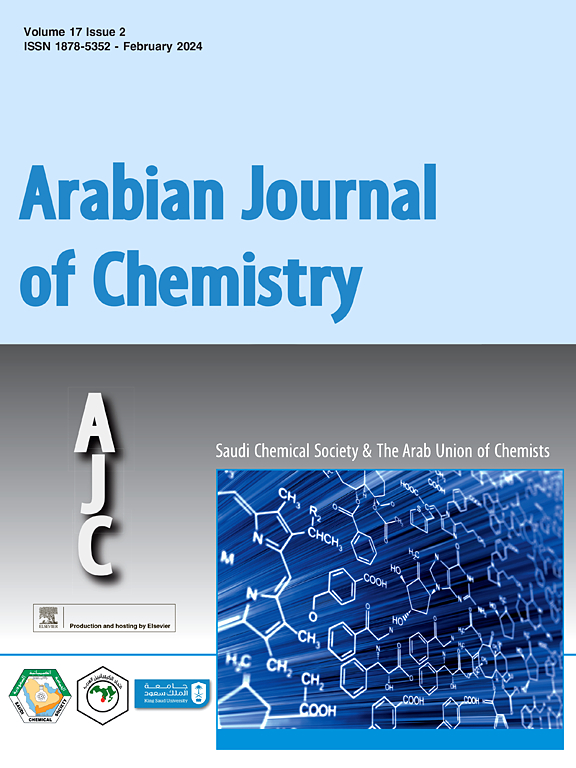Elucidating the formation mechanism of gardenia blue pigment from amino acid and genipin
IF 5.2
2区 化学
Q2 CHEMISTRY, MULTIDISCIPLINARY
引用次数: 0
Abstract
Gardenia blue (GB), a natural active blue pigment, can be synthesized from iridoid glycosides and primary amino-containing compounds in vivo and in vitro. However, limited studies have reported about GB synthetic intermediates, leading to unawareness of the formation mechanism of GB. Here, we reported that GB could be detected in rats′ feces, whose formation was simulated by in vitro reaction of amino acid-rich feces extract from rats and genipin (GP) metabolized from geniposide (GE) through β-glucosidase. Firstly, we proved that 14 amino acids (AAs) detected in rats′ feces containing primary amino groups can react with GP to produce GB. Then, taking histidine (His) as example, we characterized the key intermediates during the reaction process, including basic units genihistidine A (GH-A) and dimers. As an active basic unit, GH-A underwent covalent polymerization to form dimer, which then self-assembled into supramolecular spherical nanoparticles through multiple noncovalent interactions, including hydrogen bonds, π-π interactions, and van der Waals interactions. Our study revealed the formation mechanism of GB and provided insights into the bioavailable form of GE from traditional Chinese medicine in vivo.
阐明氨基酸和玄参素形成栀子蓝色素的机理
栀子蓝(GB)是一种天然活性蓝色色素,可在体内和体外由鸢尾甙和含初级氨基的化合物合成。然而,有关 GB 合成中间体的研究报道有限,导致人们对 GB 的形成机制缺乏了解。在此,我们报道了在大鼠粪便中可检测到国标,其形成是通过大鼠粪便提取物中富含的氨基酸与由基尼泊苷(GE)通过β-葡萄糖苷酶代谢而来的基尼泊苷(GP)的体外反应模拟的。首先,我们证明了在大鼠粪便中检测到的含有伯氨基的14种氨基酸(AAs)可与GP反应生成GB。然后,以组氨酸(His)为例,对反应过程中的关键中间产物进行了表征,包括基本单元基因组苷A(GH-A)和二聚体。作为一种活性基本单元,GH-A经过共价聚合形成二聚体,然后二聚体通过氢键、π-π相互作用和范德华相互作用等多种非共价作用自组装成超分子球形纳米颗粒。我们的研究揭示了 GB 的形成机理,并为了解中药 GE 在体内的生物可利用形式提供了见解。
本文章由计算机程序翻译,如有差异,请以英文原文为准。
求助全文
约1分钟内获得全文
求助全文
来源期刊

Arabian Journal of Chemistry
CHEMISTRY, MULTIDISCIPLINARY-
CiteScore
10.80
自引率
3.30%
发文量
763
审稿时长
63 days
期刊介绍:
The Arabian Journal of Chemistry is an English language, peer-reviewed scholarly publication in the area of chemistry. The Arabian Journal of Chemistry publishes original papers, reviews and short reports on, but not limited to: inorganic, physical, organic, analytical and biochemistry.
The Arabian Journal of Chemistry is issued by the Arab Union of Chemists and is published by King Saud University together with the Saudi Chemical Society in collaboration with Elsevier and is edited by an international group of eminent researchers.
文献相关原料
公司名称
产品信息
上海源叶
valine
上海源叶
threonine
上海源叶
tyrosine
上海源叶
serine
上海源叶
phenylalanine
上海源叶
proline
上海源叶
L-norleucine
上海源叶
methionine
上海源叶
lysine
上海源叶
leucine
上海源叶
isoleucine
上海源叶
histidine
上海源叶
glycine
上海源叶
glutamic acid
上海源叶
aspartic acid
上海源叶
arginine
上海源叶
alanine
上海源叶
geniposide
上海源叶
Genipin
 求助内容:
求助内容: 应助结果提醒方式:
应助结果提醒方式:


